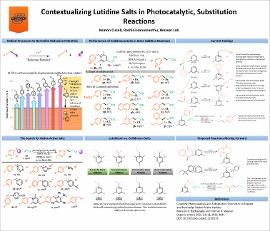| dc.contributor.advisor | Weaver, Jimmie | |
| dc.contributor.author | Cissell, Keaton | |
| dc.contributor.author | Hanumanthu, Roshini | |
| dc.date.accessioned | 2022-04-13T14:44:31Z | |
| dc.date.available | 2022-04-13T14:44:31Z | |
| dc.date.issued | 2022-04-19 | |
| dc.identifier | oksd_URS_2022_cissell | |
| dc.identifier.citation | Cissell, K., Hanumanthu, R., & Weaver, J. (2022, April 19). Contextualizing lutidine salts in photocatalytic, substitution reactions. Poster session presented at the Oklahoma State University Undergraduate Research Symposium, Stillwater, OK. | |
| dc.identifier.uri | https://hdl.handle.net/11244/335229 | |
| dc.description.abstract | Formation of new carbon-carbon bonds lies at the heart of organic chemistry. Radical intermediates are particularly well suited for reaction with a host of reaction partners to yield new carbon'carbon bonds and alkyl halides are the typical choice for precursors. Unfortunately, the difficulty of converting various alkyl halides to carbon-centered radicals varies dramatically depending on the structure. Thus, a method that could facilitate and normalize the reduction of the alkyl halides would be advantageous as it would allow this ubiquitous class of molecules to become more synthetically useful. Previous research from the group has shown that collidinium salts can be made from alkyl halides and that these salts are excellent radical precursors for photocatalytic reactions because they normalize the reduction potentials. This was demonstrated by the development of a Giese addition to electron poor alkenes to give the corresponding alkylated alkane. The collidinium salts prevented side reactions that occurred in other salts, leading to higher yields and other positive reaction attributes; however, the ortho methyl groups hindered the nucleophilicity. This reduction in nucleophilicity presented a major drawback because it made creating the salts in situ challenging. In most cases, the synthesis of the collidinium salts required high temperatures and long reaction times which limited the range of potential substrates. In this work, we are exploring lutidine salts made from the corresponding alkyl halide and lutidine (m, m-dimethylpyridine) as viable alternatives. They exhibit similar desirable properties in terms of redox potential but have a reduced steric demand which is expected to enhance the precursor's nucleophilicity and enables more facile salt formation in situ. Importantly, the undesired side reaction tends to attack at the ortho and para-position and substitution at the meta-position appears to be sufficient to halt this process. Investigation of lutidine salts under photocatalytic conditions is expected to ultimately provide a new avenue to expand the utility of alkyl halides through a dual catalysis sequence involving both photo- and nucleophilic-catalysis. | |
| dc.description.sponsorship | Oklahoma State University. Research Experiences for Undergraduates | |
| dc.format | application/pdf | |
| dc.language | en_US | |
| dc.publisher | Oklahoma State University | |
| dc.rights | In the Oklahoma State University Library's institutional repository this paper is made available through the open access principles and the terms of agreement/consent between the author(s) and the publisher. The permission policy on the use, reproduction or distribution of the article falls under fair use for educational, scholarship, and research purposes. Contact Digital Resources and Discovery Services at lib-dls@okstate.edu or 405-744-9161 for further information. | |
| dc.title | Contextualizing lutidine salts in photocatalytic, substitution reactions | |
| osu.filename | oksd_URS_2022_cissell.pdf | |
| dc.description.department | Chemistry | |
| dc.type.genre | Poster | |
| dc.type.material | Text | |
| dc.type.material | Image | |
| dc.subject.keywords | lutidine | |
| dc.subject.keywords | photocatalytic | |
| dc.subject.keywords | Giese | |
| dc.subject.keywords | reduction potential | |
